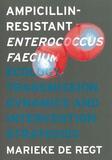Ampicillin-resistant Enterococcus faecium
Ecology, transmission dynamics and intervention strategies
Summary
For years, E. faecium only sporadically caused opportunistic infections in humans and was considered a relatively harmless commensal. In the last two decades, however, a specific polyclonal E. faecium subpopulation has rapidly become a prominent cause of nosocomial infections, which are often difficult to treat due to acquisition of resistance traits against multiple antimicrobials. These so-called hospital-derived E. faecium clones, that are characterized by ampicillin resistance, are responsible for the vast majority of hospital outbreaks and infections worldwide and are enriched with over a hundred specific genes, including (putative) virulence genes. The studies described in this thesis focus on the different forces that drive the epidemic rise of hospital-derived E. faecium. These studies demonstrated that on hospital wards where ampicillin-resistant E. faecium (ARE) colonization is endemic, ARE epidemiology is characterized by high admission, high patient-to-patient transmission and high environmental contamination rates and, as a consequence, by high infection attack rates. In particular patients of whom the intestinal flora is disrupted by the use of antibiotics are at high risk of acquiring colonization when they are exposed to ARE, either via a (re)admitted carrier or via the contaminated environment. ARE acquisition typically leads to high density intestinal colonization with E. faecium, which is probably one of the factors that contribute to successful transmission of ARE to other patients, by facilitating colonization of the skin and the inanimate environment. Colonization with ARE is only sporadically present in healthy humans in the community. Among healthy dogs and cats, however, ARE colonization was found to be prevalent. Part of the canine and feline strains were genetically indistinguishable from ARE clones that are frequently observed in nosocomial infections and outbreaks. This suggests that transfer of ARE between the animal and hospital reservoir has occurred in the past and that dogs and cats may still form an occasional source for nosocomial spread of ARE. To prevent infections it is important to control the spread of ARE. Mathematical modelling provided theoretical evidence that screening and pre-emptive isolation of patients at high risk of colonization on admission can be an effective measure to reduce endemic levels of nosocomial ARE carriage, in various different situations. It is important, though, to aim at a high sensitivity of the screening strategy, since this will yield the best efficacy at the lowest costs in the long term. In an intervention study in hospitalized patients, daily intake of probiotics, defined as representatives of the normal intestinal flora, to increase colonization resistance, unfortunately failed to prevent acquisition of ARE. The results of this thesis may form an important contribution to the development and design of infection control measures for ARE and similar nosocomial pathogens.
